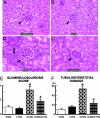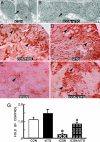Amelioration of progressive renal injury by genetic manipulation of Klotho gene
- PMID: 17287345
- PMCID: PMC1892974
- DOI: 10.1073/pnas.0611079104
Amelioration of progressive renal injury by genetic manipulation of Klotho gene
Abstract
Klotho, an antiaging gene with restricted organ distribution, is mainly expressed in the kidney tubules; the mutant mice have shortened life span, arteriosclerosis, anemia, and osteoporesis, features common to patients with chronic renal failure. Conceivably, the reduction of the Klotho gene expression may contribute to the development of kidney failure; alternatively, its overexpression may lead to the amelioration of renal injury in an ICR-derived glomerulonephritis (ICGN) mouse model with subtle immune complex-mediated disease. To address this issue, four different strains of mice were generated by cross-breeding: ICGN mice without the Klotho transgene (ICGN), ICGN mice with the Klotho transgene (ICGN/klTG), wild-type mice with the Klotho transgene (klTG), and wild-type mice without the Klotho transgene (control). At 40 weeks old, the survival rate was approximately 30% in ICGN mice, and approximately 70% in the ICGN/klTG group. This improvement was associated with dramatic improvement in renal functions, morphological lesions, and cytochrome c oxidase activity but a reduction in beta-galactosidase activity (a senescence-associated protein), mitochondrial DNA fragmentation, superoxide anion generation, lipid peroxidation, and Bax protein expression and apoptosis. Interestingly, improvement was seen in both the tubular and glomerular compartments of the kidney, although Klotho is exclusively confined to the tubules, suggesting that its gene product has a remarkable renoprotective effect by potentially serving as a circulating hormone while mitigating the mitochondrial oxidative stress.
Conflict of interest statement
The authors declare no conflict of interest.
Figures







Similar articles
-
Overexpression of klotho protein modulates uninephrectomy-induced compensatory renal hypertrophy by suppressing IGF-I signals.Biochem Biophys Res Commun. 2011 Apr 1;407(1):39-43. doi: 10.1016/j.bbrc.2011.02.089. Epub 2011 Feb 24. Biochem Biophys Res Commun. 2011. PMID: 21354104
-
Klotho gene delivery prevents the progression of spontaneous hypertension and renal damage.Hypertension. 2009 Oct;54(4):810-7. doi: 10.1161/HYPERTENSIONAHA.109.134320. Epub 2009 Jul 27. Hypertension. 2009. PMID: 19635988 Free PMC article.
-
Glucose Oxidase Induces Cellular Senescence in Immortal Renal Cells through ILK by Downregulating Klotho Gene Expression.Oxid Med Cell Longev. 2015;2015:416738. doi: 10.1155/2015/416738. Epub 2015 Oct 25. Oxid Med Cell Longev. 2015. PMID: 26583057 Free PMC article.
-
[Cognition impairment in the klotho gene mutant mice and oxidative stress].Nihon Shinkei Seishin Yakurigaku Zasshi. 2003 Oct;23(5):211-7. Nihon Shinkei Seishin Yakurigaku Zasshi. 2003. PMID: 14653227 Review. Japanese.
-
Klotho in health and disease.Curr Opin Nephrol Hypertens. 2012 Jul;21(4):362-8. doi: 10.1097/MNH.0b013e32835422ad. Curr Opin Nephrol Hypertens. 2012. PMID: 22660551 Review.
Cited by
-
The association between klotho and kidney and cardiovascular outcomes: a comprehensive systematic review and meta-analysis.Clin Kidney J. 2024 Aug 23;17(9):sfae255. doi: 10.1093/ckj/sfae255. eCollection 2024 Sep. Clin Kidney J. 2024. PMID: 39281418 Free PMC article. Review.
-
Acute Kidney Injury as a Condition of Renal Senescence.Cell Transplant. 2018 May;27(5):739-753. doi: 10.1177/0963689717743512. Epub 2018 Apr 27. Cell Transplant. 2018. PMID: 29701108 Free PMC article. Review.
-
Shedding of Klotho: Functional Implications in Chronic Kidney Disease and Associated Vascular Disease.Front Cardiovasc Med. 2021 Jan 28;7:617842. doi: 10.3389/fcvm.2020.617842. eCollection 2020. Front Cardiovasc Med. 2021. PMID: 33585584 Free PMC article. Review.
-
αKlotho and Chronic Kidney Disease.Vitam Horm. 2016;101:257-310. doi: 10.1016/bs.vh.2016.02.007. Epub 2016 Mar 24. Vitam Horm. 2016. PMID: 27125746 Free PMC article. Review.
-
A comparative transcriptome analysis identifying FGF23 regulated genes in the kidney of a mouse CKD model.PLoS One. 2012;7(9):e44161. doi: 10.1371/journal.pone.0044161. Epub 2012 Sep 6. PLoS One. 2012. PMID: 22970174 Free PMC article.
References
-
- Kuro-o M, Matsumura Y, Aizawa H, Kawaguchi H, Suga T, Utsugi T, Ohyama Y, Kurabayashi M, Kaname T, Kume E, et al. Nature. 1997;390:45–51. - PubMed
-
- Koh N, Fujimori T, Nishiguchi S, Tamori A, Shiomi S, Nakatani T, Sugimura K, Kishimoto T, Kinoshita S, Kuroki T, Nabeshima Y. Biochem Biophys Res Commun. 2001;280:1015–1020. - PubMed
-
- Sugiura H, Yoshida T, Tsuchiya K, Mitobe M, Nishimura S, Shirota S, Akiba T, Nihei H. Nephrol Dial Transplant. 2005;20:2636–2645. - PubMed
-
- Cho AR, Uchio-Yamada K, Torigai T, Miyamoto T, Miyoshi I, Matsuda J, Kurosawa T, Kon Y, Asano A, Sasaki N, Agui T. Mamm Genome. 2006;17:407–416. - PubMed
Publication types
MeSH terms
Substances
Grants and funding
LinkOut - more resources
Full Text Sources
Other Literature Sources
Medical
Molecular Biology Databases
Research Materials

